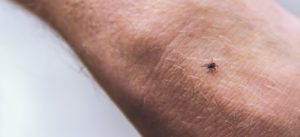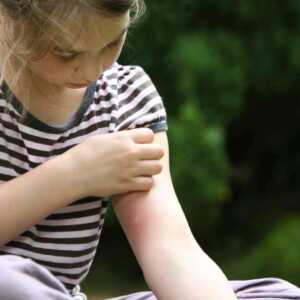[/fusion_text][/fusion_builder_column][/fusion_builder_row][/fusion_builder_container]
A: Chiggers are tiny mites commonly found in outdoor habitats, while fleas and mosquitoes are insects. Chiggers are also different from mites in that they primarily feed on skin cells rather than blood.
A: Chigger bites are not dangerous and do not transmit diseases, unlike some other insect bites which may transmit diseases.
To prevent chigger bites while in grassy or wooded areas, especially during summer and fall when chigger bites are most common, you should adopt several protective strategies. Chiggers, often called “red bugs,” are tiny mites that feed on the skin and cause intensely itchy red bumps. They usually bite humans around areas where clothing fits snugly against the skin.
Firstly, wear protective clothing when venturing into areas where chiggers live. Long pants, long-sleeved shirts, and boots can provide a physical barrier that prevents chiggers from reaching your skin. Tucking your pant legs into your socks or boots and wearing a belt can further minimize exposed skin, making it harder for chiggers to bite. Choose light-colored clothing to spot any chiggers that may climb onto your clothing.
Applying insect repellent that contains DEET or permethrin to both your skin and clothing can deter chiggers from approaching and biting you. Permethrin can be applied to clothing, where it remains effective through several washes.
Stay on cleared paths and avoid walking through tall grass or dense vegetation. Chiggers tend to congregate in warm, humid environments close to the ground, particularly in areas with thick vegetation. Sticking to the center of trails can reduce your exposure.
After returning from potentially chigger-infested areas, immediately wash your clothing in hot water and take a hot shower, scrubbing your skin with soap and water. This can remove any chiggers or their larvae before they have a chance to cause more bites. Pay special attention to areas where clothing is tight, such as around the waist or under socks, as these are spots where chiggers often bite.
Be aware of the symptoms of chigger bites and other related issues, such as the rare but serious scrub typhus transmitted by chigger-like mites in some parts of the world. Knowing how to identify and properly treat chigger bites can prevent further complications. Regularly inspect your skin and clothing for tiny red bugs or the characteristic red bumps on human skin that chigger bites usually form. If you experience unusual symptoms or suspect an infection, seek medical advice to diagnose and treat the condition effectively.
By following these measures, you can significantly reduce your risk of getting chigger bites while enjoying time outdoors, even in areas where these pests are known to live.
Chigger bites are treated primarily to alleviate the intense itching and prevent secondary infections. Initially, as soon as you suspect a chigger bite, it’s crucial to wash the affected skin with soap and water to remove any chiggers that are still attached to the skin. This can prevent further irritation and reduce the chance of bites. For the itchy skin and rash, topical treatments like calamine lotion, benadryl creams, or corticosteroid creams are often recommended to ease the symptoms. In some cases, oral antihistamines may be prescribed to relieve itching.
Chigger bites typically do not transmit diseases in the way that ticks or mosquitoes might. However, in some regions, particularly in East Asia and the Pacific, chigger mites can transmit scrub typhus, a disease caused by the bacterium Orientia tsutsugamushi. While scrub typhus is not common in the United States, it’s a reminder that bites can potentially lead to health issues beyond just itching and rash.
Chiggers, the tiny larva of a type of mite, tend to bite in warm skin folds and areas where clothing fits tightly, like around the waist or under socks. The bites may appear like red bumps or pimples and are most common during summer and fall when people are more likely to walk through grassy or wooded areas where chiggers live outdoors.
To keep chiggers at bay, avoid walking in long grass, and consider wearing long pants and long sleeves when in areas where chiggers may be present. Tucking pant legs into socks and using insect repellent can also help. If you suspect you’ve walked through an area with chiggers, promptly changing and washing clothes can prevent further bites.
While chigger bites are known for their distinctive rash, they’re typically not a serious health concern and can be treated effectively with proper care and preventive measures. If the itching doesn’t subside, or if the rash appears to be infected, it’s important to consult a healthcare professional for further advice.
Use the at home recipe exactly at posted!
Our Services
Therapeutic Massage
Infrared Sauna
Acupuncture
Facials
Zero Gravity Massage Chair
Couples Massage
[/fusion_text][/fusion_builder_column][/fusion_builder_row][/fusion_builder_container]
A: Chiggers are tiny mites commonly found in outdoor habitats, while fleas and mosquitoes are insects. Chiggers are also different from mites in that they primarily feed on skin cells rather than blood.
A: Chigger bites are not dangerous and do not transmit diseases, unlike some other insect bites which may transmit diseases.
To prevent chigger bites while in grassy or wooded areas, especially during summer and fall when chigger bites are most common, you should adopt several protective strategies. Chiggers, often called “red bugs,” are tiny mites that feed on the skin and cause intensely itchy red bumps. They usually bite humans around areas where clothing fits snugly against the skin.
Firstly, wear protective clothing when venturing into areas where chiggers live. Long pants, long-sleeved shirts, and boots can provide a physical barrier that prevents chiggers from reaching your skin. Tucking your pant legs into your socks or boots and wearing a belt can further minimize exposed skin, making it harder for chiggers to bite. Choose light-colored clothing to spot any chiggers that may climb onto your clothing.
Applying insect repellent that contains DEET or permethrin to both your skin and clothing can deter chiggers from approaching and biting you. Permethrin can be applied to clothing, where it remains effective through several washes.
Stay on cleared paths and avoid walking through tall grass or dense vegetation. Chiggers tend to congregate in warm, humid environments close to the ground, particularly in areas with thick vegetation. Sticking to the center of trails can reduce your exposure.
After returning from potentially chigger-infested areas, immediately wash your clothing in hot water and take a hot shower, scrubbing your skin with soap and water. This can remove any chiggers or their larvae before they have a chance to cause more bites. Pay special attention to areas where clothing is tight, such as around the waist or under socks, as these are spots where chiggers often bite.
Be aware of the symptoms of chigger bites and other related issues, such as the rare but serious scrub typhus transmitted by chigger-like mites in some parts of the world. Knowing how to identify and properly treat chigger bites can prevent further complications. Regularly inspect your skin and clothing for tiny red bugs or the characteristic red bumps on human skin that chigger bites usually form. If you experience unusual symptoms or suspect an infection, seek medical advice to diagnose and treat the condition effectively.
By following these measures, you can significantly reduce your risk of getting chigger bites while enjoying time outdoors, even in areas where these pests are known to live.
Chigger bites are treated primarily to alleviate the intense itching and prevent secondary infections. Initially, as soon as you suspect a chigger bite, it’s crucial to wash the affected skin with soap and water to remove any chiggers that are still attached to the skin. This can prevent further irritation and reduce the chance of bites. For the itchy skin and rash, topical treatments like calamine lotion, benadryl creams, or corticosteroid creams are often recommended to ease the symptoms. In some cases, oral antihistamines may be prescribed to relieve itching.
Chigger bites typically do not transmit diseases in the way that ticks or mosquitoes might. However, in some regions, particularly in East Asia and the Pacific, chigger mites can transmit scrub typhus, a disease caused by the bacterium Orientia tsutsugamushi. While scrub typhus is not common in the United States, it’s a reminder that bites can potentially lead to health issues beyond just itching and rash.
Chiggers, the tiny larva of a type of mite, tend to bite in warm skin folds and areas where clothing fits tightly, like around the waist or under socks. The bites may appear like red bumps or pimples and are most common during summer and fall when people are more likely to walk through grassy or wooded areas where chiggers live outdoors.
To keep chiggers at bay, avoid walking in long grass, and consider wearing long pants and long sleeves when in areas where chiggers may be present. Tucking pant legs into socks and using insect repellent can also help. If you suspect you’ve walked through an area with chiggers, promptly changing and washing clothes can prevent further bites.
While chigger bites are known for their distinctive rash, they’re typically not a serious health concern and can be treated effectively with proper care and preventive measures. If the itching doesn’t subside, or if the rash appears to be infected, it’s important to consult a healthcare professional for further advice.
Use the at home recipe exactly at posted!
Our Services
Therapeutic Massage
Infrared Sauna
Acupuncture
Facials
Zero Gravity Massage Chair
Couples Massage
What are chiggers, and what do they look like? The truth is, you might not see the chiggers — they measure just 1/150th of an inch, making them nearly invisible to the naked eye — but you’ll definitely see their itchy, skin-irritating results after you’ve spent some time outside.

What Is a Chigger?
Also known as harvest mites, berry bugs, red bugs, and harvest lice, these tiny red bugs are parasitic mites (Trombiculidae). When people ask, “What are chiggers?” they’re usually picturing bugs when, in reality, these pests have eight legs and are related to spiders. They can leave their mark on you after a stroll through the forest, a sunny game of golf, or a playdate with your children in a park.
Chiggers are found inhabiting grassy or outdoor areas, particularly those situated near lakes and streams. They flourish in warm temperatures, particularly during the summer and fall months. Once chiggers latch onto clothing, their bites cause them to penetrate through the fabric to reach exposed skin. Typically, chigger bites result in itchiness at the point of contact with the skin, which often occurs near the seams of tight-fitting garments.
The good news is that you don’t have to suffer needlessly thanks to natural remedies that soothe chigger-related bites and keep the pesky bugs at bay.
What Are Chigger Bites?
When chigger larvae attach to your clothing, they burrow into your skin to feed. To accomplish this, the larvae will excrete a digestive enzyme onto your skin which dissolves skin cells. The dead skin cells will then harden into a microscopic tube (stylostome) for the chigger to suck up your skin tissue. The chigger’s saliva can cause severe itching that peaks within 24-48 hours of contact and slowly subsides over the following two weeks. Scratching can cause chiggers to detach from the skin.
Signs & Symptoms of Chigger Bites
Identifying Chigger Bites:
When adult chiggers bite you, you won’t feel it. These insects are so small that the bite itself is relatively painless. However, as the enzymes they inject into you begin to spread through your skin, you’ll start to see skin irritation and specific symptoms including:
- Hives
- Small red bumps that might look like pimples with a small white cap on the top of each bump
- Severe itching
The symptoms usually begin to appear within a few hours of being bitten. The rash usually appears on very specific areas of your body: Skin that’s exposed and open to the sunlight, and usually on your legs from where your shoes and socks are up to where your underwear touches your skin.
How long do the bites last?
Everybody responds differently to insect bites, but for most people, when chigger bites occur, the bumps begin to go away after two days.
What’s the difference between chigger bites vs. bed bug bites vs. mosquito bites vs. flea bites?
Chigger bites will disappear on their own as long as you limit or avoid the outdoors after your initial bites. In contrast, bed bugs continue to bite you daily and the rash doesn’t go away. Additionally, while chiggers leave little red welts only on skin that was exposed outdoors, bed bugs create raised bumps in zig-zag patterns over your entire body.
Mosquito bites appear as raised, itchy bumps on the skin. Mosquitoes usually bite exposed skin and are most active during dawn and dusk. They can transmit diseases such as West Nile virus and malaria.
Flea bites are also itchy, red bumps that typically occur in clusters or lines. Fleas tend to bite around ankles or feet and can live on pets. Flea bites can cause allergic reactions and can also transmit diseases such as typhus.
Causes & Risk Factors
Your risks of experiencing symptoms increase depending on a combination of factors, such as timing and environment.
People stereotypically attribute chigger risks to the summer season, when in reality, the pests are active from the spring season through to the fall.
And while any period spent outdoors can expose you to chiggers, these pests like to climb to the top of branches and long grass before dropping down onto an unsuspecting victim’s legs or feet.
Several specific areas of the landscape are especially prone to chigger infestations:
- The edges of forests and woodlands
- Anywhere with tall patches of weeds or grass
- Patches of blackberries, raspberries, and other berry plants (wild or cultivated)
Do chiggers spread on your body?
After dropping down from a branch of a blade of grass, the chiggers will crawl across exposed skin looking for a good place to settle down, take a bite, and begin to feed. Thus, while people often start to notice the rash on their ankles, lower legs or skin folds, it can easily spread as the chiggers find new spots to bite.
Conventional Treatment for Chigger Bites
How do you get rid of chigger bites? What gets rid of chigger bites?
Your doctor or health professional usually diagnoses a chigger bite simply by examining your skin, as the rash has a very simple, telltale appearance and is usually localized to specific areas of your body. During the examination, your doctor will likely ask you about recent outdoor activities, such as picnics, outdoor sports, or hikes. This usually gives him or her all the information he needs to be confident that it’s chigger-related.
How long does it take to get chigger bites relief?
Conventional chigger bite treatment typically focuses on simply managing the itching, as the rash wears off on its own as the chiggers’ digestive enzymes cease to be active. Over-the-counter medications are usually recommended, including antihistamines that help ease redness and irritation.
How to Get Rid of Chiggers
What kills chiggers on the skin? Do chigger bites go away on their own?
When it comes to getting rid of chiggers on your body, it’s usually a non-issue.
It takes the pests approximately four days to eat if they’re undisturbed, but the unseen chiggers are usually brushed off your skin by your clothes or removed by you unconsciously as you scratch at the bites long before they’re finished eating. Once they’re accidentally dislodged from your skin, the chiggers die almost immediately.
When it comes to chiggers in the landscape, getting rid of the pests involves new approaches to garden maintenance. Chiggers are attracted to specific types of plants and landscape styles, so it’s critical to focus on those areas:
- Cut back tall vegetation, as chiggers like to climb to the tallest points of plants.
- Clear away weeds.
- Keep your lawns trimmed short. Doing this helps reduce humidity around the plants and also raises the soil temperature, helping to kill chiggers and chigger eggs.
5 Natural Home Remedies for Chigger Bites
While oral or topical medications are often recommended to treat chigger bites, several natural home remedies or diy chigger bite treatments can quickly and effectively reduce the spread of the rash and keep skin discomfort at a minimum.
What is the best cure for chigger bites?
1. Take a Warm Shower
If you suspect you may have been exposed to chiggers, or you simply want to do daily prevention maintenance, take a warm shower immediately after a potential exposure (i.e. walks in a park, hikes in the forest, gardening among tall grasses or shrubs, etc.).
This can quickly and effectively get rid of unseen bugs, dramatically reduce the number of bites, and prevent chigger bites from spreading, and is usually the first step for this chigger remedy. Use soap or shower gel and an exfoliator or cloth and scrub your entire body.
Because chiggers like to crawl, scrub everywhere and not just where you might see a few initial bites. Pay special attention to your ankles and legs.
Once you’re done scrubbing, rinse off with very cold water, which can help soothe your skin and reduce scratching.
2. Apply Calamine Lotion
Calamine lotion is a natural topical medication made from zinc and is one of the best remedies for chigger bites. Historians have found evidence of its use for skin itching as far back as the Egyptian civilizations of 1500 B.C.
It’s commonly used as an anti-itch treatment for chiggers as well as other forms of insect bites. Apply little dabs of this pink liquid to affected skin areas once in the morning and again in the afternoon or whenever needed.
3. Create a Baking Soda Compress

Baking soda has natural skin-soothing properties. To control the chigger bite itch, as well as itching from all sorts of insect bites, mix equal parts of baking soda and water to create a thick paste. Spread it onto the chigger rash and let it sit for 20 minutes before rinsing and patting dry.
4. Take a Natural Antihistamine
While your doctor may suggest commercial antihistamines, talk with him or her about the appropriateness of natural alternatives. This is likely the best chigger bite medicine.
In a study published in the Alternative Medicine Review medical journal, study participants took 300 milligrams of stinging nettle a day. Nearly 60 percent of the participants said the nettle worked effectively, and nearly 70 percent of them rated the stinging nettle as being more effective than the placebo.
Other natural enzymes and ingredients that may be just as effective at treating chigger bites as drug-based antihistamines include:
- Vitamin C (2 grams of vitamin C per day)
- Bromelain, an enzyme in pineapples (500 mg taken three times a day)
- Quercetin, an antioxidant in onions (dosage varies based on the form of quercetin)
5. Cool Your Skin
Keeping your skin cool can help reduce irritation and soothe topical redness. Use a cold towel compress, or consider soaking green tea or black tea bags, placing them in your fridge for a few hours, and then applying them to your skin (the antioxidants in the tea can help nourish and heal your skin).
Tips to Help Prevent Chigger Bites
The next time you’re heading out for a picnic or getting down to play a yard game, check for chiggers so you can avoid that specific area of grass or park where chiggers live: Lay a piece of dark cardboard on the ground. Within a few minutes, pink or yellow or little red bugs will show up on the cardboard if chiggers are present.
If you’re unsure if chiggers are present or simply determined to enjoy the outdoors during warm weather regardless of them, you can take simple steps to reduce your risks of getting bitten:
- When walking or hiking in the woods, avoid overgrown areas or tall grass and stick to clear trails or paths.
- Wear long sleeves and long pants to cover as much skin as possible.
- Take a shower immediately after finishing outdoor recreation.
- Wash your clothes before wearing them again.
- Applying insect repellent, like deet insect repellent, to your clothes and shoes can also be effective.
While there are many insecticide-based options on the market, when it comes to home remedies for chigger bites, you can also make your own repellent using natural ingredients. In a clean spray bottle, combine 25 drops of sassafras essential oil (or clove oil as an alternative) with 2 tablespoons of olive oil and a tablespoon of aloe vera gel. Shake to combine thoroughly, then spritz on yourself before heading outdoors.
Precautions
The chigger bites themselves are relatively harmless, besides being extremely itchy. Try to avoid scratching the bumps, as this breaks your skin and can increase your risk of skin infection.
Key Points about Chigger Bites
Chiggers are almost invisible to the naked eye, but their irritating bites can appear after you’ve spent a day outdoors:
- They are commonly considered a summer problem but present from the spring through the fall.
- The symptoms, including hives, itching, and small pimple-like bumps, appear within a few hours of being bitten.
- The bites are typically restricted to bare skin exposed to sunlight.
- Risks of chigger bites go up if you spend time in and around tall grasses, bushes, and the edges of the woods.
Symptoms typically go away after a few days, but those few days can include intense itching and skin rashes.
5 Natural Alternatives to Help Reduce and Treat Chigger Symptoms
- Take a warm shower and scrub you skin with soap and water.
- Applying a soothing calamine lotion.
- Create a baking soda paste and let it soak into your skin for 20 minutes.
- Take a natural antihistamine, such as stinging nettle.
- Keeping your skin cool and calm with cold compresses (e.g. chilled tea bags)
My Favorite Chigger Bite Remedy
I want to share my go-to remedy for alleviating the intense itching caused by chigger bites. With firsthand experience dealing with these pesky bites, I have discovered a highly effective treatment that has provided me much-needed relief. Read on to learn about this game-changer remedy that ensures chigger bites are no longer a cause for distress.
Say goodbye to the relentless itch and discomfort of chigger bites with my ultimate bite remedy! This tried and tested recipe combines equal parts of soothing Benadryl cream and Lidocaine to provide instant relief upon application. The magic doesn’t stop there, as the next step involves adding equal parts of over-the-counter anti-itch hydrocortisone cream to reduce inflammation and redness further. But wait, there’s more! For an extra dose of cooling comfort, I top it off with a Tucks pad gently taped over the affected area, providing a calming sensation that eases the urge to scratch. This potent concoction is a game-changer, ensuring that these bites are gone fast!
1/4 Benedryl Cream
1/4 Lidocaine
1/2 Hydrocortisone Cream
Covered with a Tucks Pad
In conclusion, these bites can be a distressing experience due to the intense itching and discomfort they cause. However, there are several effective home remedies that can help to alleviate these symptoms and promote faster healing. From using essential oils to creating a homemade baking soda paste, there are various options that you can try to soothe the bites naturally. Always remember to keep the affected area clean, avoid scratching, and seek medical attention if any signs of infection or allergic reaction occur. With these tips and remedies, you can quickly reduce the discomfort and get back to enjoying the great outdoors.
Want to use essential oil on your pets? Read this before you do!
A: Chiggers are tiny mites commonly found in outdoor habitats, while fleas and mosquitoes are insects. Chiggers are also different from mites in that they primarily feed on skin cells rather than blood.
A: Chigger bites are not dangerous and do not transmit diseases, unlike some other insect bites which may transmit diseases.
To prevent chigger bites while in grassy or wooded areas, especially during summer and fall when chigger bites are most common, you should adopt several protective strategies. Chiggers, often called “red bugs,” are tiny mites that feed on the skin and cause intensely itchy red bumps. They usually bite humans around areas where clothing fits snugly against the skin.
Firstly, wear protective clothing when venturing into areas where chiggers live. Long pants, long-sleeved shirts, and boots can provide a physical barrier that prevents chiggers from reaching your skin. Tucking your pant legs into your socks or boots and wearing a belt can further minimize exposed skin, making it harder for chiggers to bite. Choose light-colored clothing to spot any chiggers that may climb onto your clothing.
Applying insect repellent that contains DEET or permethrin to both your skin and clothing can deter chiggers from approaching and biting you. Permethrin can be applied to clothing, where it remains effective through several washes.
Stay on cleared paths and avoid walking through tall grass or dense vegetation. Chiggers tend to congregate in warm, humid environments close to the ground, particularly in areas with thick vegetation. Sticking to the center of trails can reduce your exposure.
After returning from potentially chigger-infested areas, immediately wash your clothing in hot water and take a hot shower, scrubbing your skin with soap and water. This can remove any chiggers or their larvae before they have a chance to cause more bites. Pay special attention to areas where clothing is tight, such as around the waist or under socks, as these are spots where chiggers often bite.
Be aware of the symptoms of chigger bites and other related issues, such as the rare but serious scrub typhus transmitted by chigger-like mites in some parts of the world. Knowing how to identify and properly treat chigger bites can prevent further complications. Regularly inspect your skin and clothing for tiny red bugs or the characteristic red bumps on human skin that chigger bites usually form. If you experience unusual symptoms or suspect an infection, seek medical advice to diagnose and treat the condition effectively.
By following these measures, you can significantly reduce your risk of getting chigger bites while enjoying time outdoors, even in areas where these pests are known to live.
Chigger bites are treated primarily to alleviate the intense itching and prevent secondary infections. Initially, as soon as you suspect a chigger bite, it’s crucial to wash the affected skin with soap and water to remove any chiggers that are still attached to the skin. This can prevent further irritation and reduce the chance of bites. For the itchy skin and rash, topical treatments like calamine lotion, benadryl creams, or corticosteroid creams are often recommended to ease the symptoms. In some cases, oral antihistamines may be prescribed to relieve itching.
Chigger bites typically do not transmit diseases in the way that ticks or mosquitoes might. However, in some regions, particularly in East Asia and the Pacific, chigger mites can transmit scrub typhus, a disease caused by the bacterium Orientia tsutsugamushi. While scrub typhus is not common in the United States, it’s a reminder that bites can potentially lead to health issues beyond just itching and rash.
Chiggers, the tiny larva of a type of mite, tend to bite in warm skin folds and areas where clothing fits tightly, like around the waist or under socks. The bites may appear like red bumps or pimples and are most common during summer and fall when people are more likely to walk through grassy or wooded areas where chiggers live outdoors.
To keep chiggers at bay, avoid walking in long grass, and consider wearing long pants and long sleeves when in areas where chiggers may be present. Tucking pant legs into socks and using insect repellent can also help. If you suspect you’ve walked through an area with chiggers, promptly changing and washing clothes can prevent further bites.
While chigger bites are known for their distinctive rash, they’re typically not a serious health concern and can be treated effectively with proper care and preventive measures. If the itching doesn’t subside, or if the rash appears to be infected, it’s important to consult a healthcare professional for further advice.
Use the at home recipe exactly at posted!
Our Services
Therapeutic Massage
Infrared Sauna
Acupuncture
Facials
Zero Gravity Massage Chair
Couples Massage
Related Posts
Our Hours
M-Th 9am-7pm
F 9am-5pm
Sat 9am-2pm
Sun 11am-6pm
Receptionist on duty during the above hours. Appointments are taken outside of these hours.
Contact Info
180 Postage Drive Suite 100 Pickerington, OH 43147
Phone: 6146046358
Email: [email protected]
Serving Areas
Pickerington, Ohio
Columbus, Ohio
Reynoldsburg, Ohio
Canal Winchester, Ohio
Baltimore, Ohio
Groveport, Ohio
Lancaster, Ohio
Gahanna, Ohio
Blacklick, Ohio
Pataskala, Ohio







